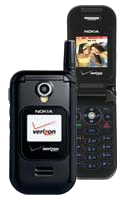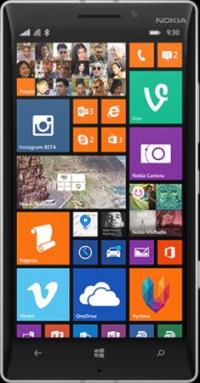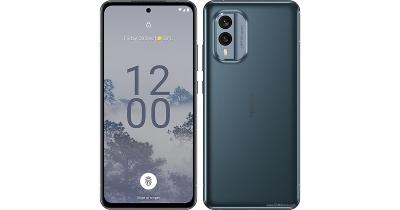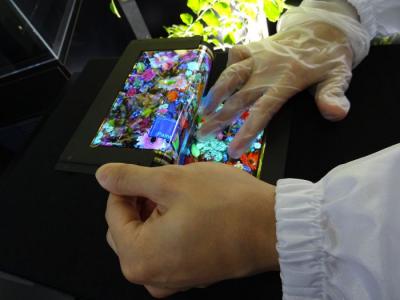Nokia was once the world's leading mobile phone company. They were late to the smartphone revolution, and the company's mobile phone arm was sold in 2013 to Microsoft. The Nokia phone brand was sold by Microsoft in 2016 to HMD Global, a new company founded by ex-Nokia executives.
Nokia's first OLED phone
Back in 2006, Nokia introduced the 6215i phone that was actually a re-branded clamshell Pantech PN-315 handset, for the Verizon network in the US. The phone had a 65K, 97x64 PMOLED subdisplay.

Nokia AMOLED phones - past and present
In its Symbian days, before the rise of the modern smartphone, Nokia released several AMOLED Symbian phones to the market - such as the N85 and the N86, the N8 and the E7 and the C7. In most of these AMOLED phones, Nokia used their ClearBlack Display technology (CBD) - which adds a polarized filter to the AMOLED and is said to deliver better outdoor visibility.
 Nokia N86
Nokia N86When Nokia abandoned Symbian in favor of Microsoft's Windows Phone OS, they continued to use OLED displays in most of their phones - the latest one was the Lumia 930, the flagship 2014 Windows Phone 8.1 smartphone. The Lumia 930 has a 5" Full-HD Super AMOLED ClearBlack display, a 2.2 Ghz quad core CPU, 20 MP PureView camera (with optical image stabilization), Qi wireless charging and NFC.

HMD Global, who now owns the global Nokia smartphone brand, has released several new smartphones - one example was the Nokia 8 Sirocco in February 2018 - with its flexible (edge-type) 5.5" 1440x2560 (534 PPI) P-OLED display - reportedly made by LG Display. In 2022 the company announced the X30 Android smartphone, with a 6.43" 90Hz 1080x2400 AMOLED display, a Qualcomm Snapdragon 695 chipset, 6/8 GB of RAM, 128/256 GB of storage and a dual camera setup. The X30 is shipping, starting at around $500 (Note: link to Amazon.co.uk).

Nokia OLED research
Nokia was also engaged in high-end OLED research. In June 2014, for example, Japan's Semiconductor Energy Laboratory, in collaboration with Nokia unveiled a new foldable OLED display - see image below.

The latest Nokia OLED news:
LGDisplay are cautious about OLEDs , do not see big investments soon
 LGD’s aim is to approach investment of AMOLED in a careful way. Kwon said, Expect for Nokia, no company shows aggressive leadership. Considering productivity and original cost, there will be no big investments for AMOLED.
LGD’s aim is to approach investment of AMOLED in a careful way. Kwon said, Expect for Nokia, no company shows aggressive leadership. Considering productivity and original cost, there will be no big investments for AMOLED.
LGD considered mass-production investment for AM OLED panel but decided to invest in only 1 line of 3.5 generation. And Toki was selected as major equipment supplier for equipment.
Mobile phones makers are slow to adapt to OLEDs, but 60% of new MP3 players have them
 DisplaySearch says that SamsungSDI's AMOLED second quarter shipments are down 22% from previous quarter (the forecase was an increase of 12%) due to low demand from phone makers, including Nokia. The slowdown is expected to continue in the next quarter.
DisplaySearch says that SamsungSDI's AMOLED second quarter shipments are down 22% from previous quarter (the forecase was an increase of 12%) due to low demand from phone makers, including Nokia. The slowdown is expected to continue in the next quarter.
Total AMOLED revenue was 54M$, down 27% quarter to quater.
PMOLED shipments are up 17% from previous quarter (20M$), after 3 quarters of slowing down. PMOLEDs are now 60% of the MP3 players market.
RiTdisplay had a record quarter with revenues of US$33.8 million. Pioneer maintained its shipment volume of 4.4 million units, most of which were monochrome displays. Chi Mei EL (CMEL) also reported AMOLED revenues of only US$7.6 million, down from US$12.8 million last quarter.
Nokia decided that their panel suppliers must be able to make AMOLEDs as the tech will play a major role
 Digitimes reports that Nokia has decided that the capability to make AMOLEDs is a condition for the selection of its panel suppliers. Nokia expects AMOLED to play a major role in the market in the future.
Digitimes reports that Nokia has decided that the capability to make AMOLEDs is a condition for the selection of its panel suppliers. Nokia expects AMOLED to play a major role in the market in the future.
Nokia already has OLED displays in a couple of high-end products (the 8800 Art, the 7900 Prism and the 6600). The AMOLED displays are so beautiful that they really make an impact (maybe Nokia also read C|Net's review of the iRiver SPINN)
AU Optronics (AUO) and TPO Display, two panel suppliers for Nokia, are gearing up the development of AMOLED applications, the sources indicated.
TPO said it has a team that has been developing AMOLED, and the company also runs a small test line for the segment. But for volume production to start in the future when its technologies mature, TPO will have to install more equipment, the company added.
UDC Reviews Company and OLED Industry Progress
 At their yearly share holder meeting, UDC reviewed their company's and the OLED industry's progress. UDC also highlights continued adoption of its energy-efficient PHOLED technology in commercial displays and advances in its flexible OLED, white OLED lighting, and printable, phosphorescent P(2)OLED(TM) technologies.
At their yearly share holder meeting, UDC reviewed their company's and the OLED industry's progress. UDC also highlights continued adoption of its energy-efficient PHOLED technology in commercial displays and advances in its flexible OLED, white OLED lighting, and printable, phosphorescent P(2)OLED(TM) technologies.
Universal Display’s Chief Executive Officer, Steven V. Abramson, began the meeting by reviewing progress in the commercialization of the Company’s OLED technologies over the past year. Mr. Abramson followed this by highlighting advances in next generation technologies for display and lighting applications, and providing a vision of the future for the Company and the OLED industry.
The last year has seen a number of steps forward for both Universal Display and the OLED industry, Mr. Abramson stated. Our high efficiency, phosphorescent OLED technology is essential for the production of low-power consumption displays. Through commercial agreements with industry leaders, we have seen increasing numbers of active-matrix OLED displays that use our technology, in products that include KDDI, Nokia, Sony Ericsson and Toshiba cell phones, as well as iRiver and Teclast multi-media players. As the market for smaller-area OLED displays solidifies, the next wave of product applications like laptops, computer monitors and TVs is taking shape. A number of announcements have also been made about an increasing demand for AMOLED displays and plans to expand production capacity to meet this demand. As the market continues to grow, we believe that we are well-positioned to participate in that growth.
Mr. Abramson also highlighted progress in the Company’s core OLED technologies. In addition to reviewing the Company’s 102 lm/W breakthrough in white OLEDs that was reported two days earlier, Mr. Abramson discussed key advances in PHOLED, P2OLED and flexible OLED technologies. He also reported a new blue PHOLED material system, at CIE(0.16, 0.25) with over 15,000 hours of operating lifetime (to 50% initial luminance) at 500 nits, which is nearly double the lifetime reported a year ago.
In addition, Mr. Abramson highlighted a number of exciting prototypes on exhibit at the meeting that demonstrate the Company’s core technologies. These included a flexible OLED display built in collaboration with LG Display and partially supported by the U.S. Department of Defense. Also on display were inkjet-printed samples built using the Company’s solution-processible P2OLED technology and materials, and examples of commercial products with OLED displays from CMEL, Pioneer and Samsung SDI. Other technical advances, including those in the Company’s infra-red OLED and organic vapor-jet printing technologies, were also described.
Mr. Abramson concluded, Today, OLED technology is commercial, offering its benefits to manufacturers and consumers alike. The near future will bring bigger and brighter displays, OLED TVs will become even more common, and our next-generation technologies will continue to be refined and advanced. Our phosphorescent OLED technology offers a real ‘green’ solution for display and lighting applications with its energy efficiency and environmental appeal. We believe that our UniversalPHOLED and other OLED technologies will be at the very core of this progress.
Samsung SDI’s AMOLEDs Reach Mass Production; Drives Q4’07 OLED Display Revenues to US$158.8M

DisplaySearch reports that Samsung SDI drove the market, pushing shipments to 20.2M, which was up 30% Q/Q but down 9% Y/Y. For the year, total revenues grew 6% to US$493.9M (see Table 1) and total shipments grew 8% to 74.7M, according to the DisplaySearch Quarterly OLED Shipment and Forecast Report. The report findings also show that the shipment mix is changing, as AMOLEDs had a 9.7% share of total revenues in Q3’07, which jumped to 41% in Q4’07.
Key findings in the DisplaySearch report include
- Samsung SDI was #1 in total revenue with US$79.4M, more than double the #2 supplier RiTdisplay at US$30.3M.
- RiTdisplay retained its lead in shipments at 6.6M units with Samsung SDI following at 4.9M units.
Pioneer was #3 in units and #3 in shipments. - Sony shipped 2K 11 displays for use in the XEL-1 in December and is expected to ship 6K panels in Q1’08.
- Chi Mei EL increased its production of AMOLED panels, shipping 60K units in Q4’07 up from 16K in Q3’07.
- LG Display, formerly LG. Philips LCD, took over LGE’s PMOLED fab and is expected to ship ~150K AMOLED panels in Q1’08 for use in the recently announced LG-SH150A.
AMOLEDs are beginning to hit their stride in the small/medium market with Nokia, Samsung, LG and Sony Ericsson all releasing products in Q4’07. We expect to see multiple product introductions in the next two quarters, and the panel size will jump to 2.6 and larger compared to previously announced 2.2-2.4 models, said Barry Young, a senior DisplaySearch advisor.
Read more here (DisplaySearch)
Q3'07 OLED Display Revenues Disappoint as Samsung SDI's AMOLED Program Is Slow to Reach Full Production
 In what was expected to be a strong quarter with Samsung SDI reaching their full production goal of 1.5 million AMOLED displays per month, the company barely reached the 100K mark down from 350K in Q2’07 as reported in DisplaySearch’s latest Quarterly OLED Shipment and Forecast Report. The low production level left the OLED display industry with revenues of only US$78.3M in Q3’07 down 38% Y/Y and 31% Q/Q. Shipments were 15.5M for the quarter, down 32% Y/Y and 22% Q/Q. The low production for the industry was also impacted by LGE, one of the industry leaders, shifting resources from PMOLEDs to AMOLEDs and shipping only 310K units vs. 3.1M in the prior quarter and Sony with no AMOLED production as the company prepared to begin shipping the XEL-1, the world’s first AMOLED TV in December ’07. The news was not all bad as:
In what was expected to be a strong quarter with Samsung SDI reaching their full production goal of 1.5 million AMOLED displays per month, the company barely reached the 100K mark down from 350K in Q2’07 as reported in DisplaySearch’s latest Quarterly OLED Shipment and Forecast Report. The low production level left the OLED display industry with revenues of only US$78.3M in Q3’07 down 38% Y/Y and 31% Q/Q. Shipments were 15.5M for the quarter, down 32% Y/Y and 22% Q/Q. The low production for the industry was also impacted by LGE, one of the industry leaders, shifting resources from PMOLEDs to AMOLEDs and shipping only 310K units vs. 3.1M in the prior quarter and Sony with no AMOLED production as the company prepared to begin shipping the XEL-1, the world’s first AMOLED TV in December ’07. The news was not all bad as:
- RiTdisplay had a record quarter and led in revenues with US$31.0M and units with US$6.4M.
- Pioneer was #2 in units and #3 in shipments, while Samsung SDI, the only company shipping both PMOLEDs and AMOLEDs, was #3 in units and #2 in shipments.
- Samsung SDI has already upped its production and expects to ship >2M units in Q4’07, while RiTdisplay should continue its explosive performance with shipments of more than 7M units, a new record for one supplier.
- Chi Mei EL also started production of AMOLED displays with volume of 16K, a number they expect to double in Q4’07.
- MED joined eMagin as the only two companies shipping microdisplay-based OLEDs.
Samsung SDI was able to announce a number of design wins with the Japanese mobile phone carrier AU announcing AMOLED main display mobile phones by Sony Ericsson, Toshiba, Hitachi and Sanyo. Previously, Samsung SDI announced design wins with Nokia and Kyocera. The new AMOLED main displays are all in the 2.8 category, which should help the mobile phone makers recover the premium prices charged for AMOLED displays.
CMEL ramps up production of AMOLEDs, hope to supply to a top-five mobile maker
 Chi Mei El Corp (CMEL), the OLED manufacturing arm of Chi Mei Optoelectronics Corp, said yesterday it aims to start supplying displays for a top-five mobile phone manufacturer by the end of the year.
Chi Mei El Corp (CMEL), the OLED manufacturing arm of Chi Mei Optoelectronics Corp, said yesterday it aims to start supplying displays for a top-five mobile phone manufacturer by the end of the year.
CMEL is in talks with several potential customers, including Samsung Electronics Co and Nokia Ojy, said Douglas Park, a vice president of CMEL.
"We hope to land at least one of them by the end of this year," Park said.
To cope with rising demand, Park said CMEL planned to spend NT$800 million (US$24.2 million) to more than double its monthly output to 1.2 million units by the first quarter of 2008, from it current 500,000 units.
In February, CMEL ramped up production of active matrix OLED displays for mobile phones, digital cameras and global positioning systems.
First 'Nokia' phone with an OLED display
 The first Nokia phone with an OLED display is now available from Verizon. The phone has a 65k, 96x64 resolution OLED subdisplay.
The first Nokia phone with an OLED display is now available from Verizon. The phone has a 65k, 96x64 resolution OLED subdisplay.
The entry-level clamshell phone is actually a rebranded Pantech PN-315 handset. The handset supports CDMA networks on the 800 and 1900MHz bands and uses 1xRTT for data. It weighs 94g (3.3oz) and measures in at 89mm x 46mm x 18mm (3.5" x 1.8" x 0.7").
Pagination
- Previous page
- Page 8



